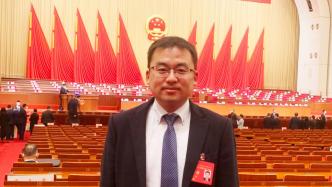

Jiang Xuefeng, a member of the Shanghai CPPCC and a professor at the School of Chemistry and Molecular Engineering at East China Normal University, said in the proposal that to achieve the goals of science education, not only policy support and funding are needed, but also the full-scale participation of families, society, schools, and scientific researchers. , giving learners the opportunity to truly immerse themselves in scientific practice.
On January 24, ThePaper Technology learned that during the second session of the 14th Shanghai Municipal Committee of the Chinese People’s Political Consultative Conference, Jiang Xuefeng, a member of the Shanghai Municipal Committee of the Chinese People’s Political Consultative Conference and a professor at the School of Chemistry and Molecular Engineering at East China Normal University, planned to submit two proposals, proposing the establishment of a multi-disciplinary evaluation system for education and scientific research. A centralized and multi-dimensional evaluation system is required to prevent the involution of education and scientific research.
In addition, he suggested establishing scientific education that is not quantitative, but systematic and dialectical.
He said that an analysis of the century-old Nobel Prizes around the world shows that the degree of specialization of the highest degree of Nobel laureates in the United States is declining. Science education cultivates long-term research and practical abilities, not just accumulation of knowledge.
How to break the involution of education and scientific research?
Meaningless involution leads to a waste of educational and scientific research resources.
A score of 96 is more successful than a score of 95, 10 articles published is more successful than 8 articles, an impact factor of 50 is more successful than 30...
"Is this really the case?" Jiang Xuefeng asked.
In his proposal, he said that in an over-quantified and over-indexed system, people no longer modestly forge ahead, but instead become time-consuming and labor-intensive involution. When we use a single score to quantify our evaluation, people start to focus on the score. However, without quantification and indicators, the fairness and objectivity of evaluation will be lost. This seems to be a paradoxical problem.
In response to the above problems, Jiang Xuefeng believes that a diversified, diversified, and multidimensional evaluation system is the best way to eliminate involution, which is especially important for educational evaluation and scientific research evaluation.
He said that this kind of evaluation is a "holographic image" and can fully understand a three-dimensional person.
For example, to evaluate a student, at least five dimensions are needed: in addition to academics, the child's emotional intelligence to help each other and get along with others, the reverse quotient to make progress after experiencing setbacks, the social responsibility of the community and the community, and the sense of responsibility of the family and family should all be considered in the comprehensive evaluation. within the evaluation parameters.
Regarding the evaluation of scientific research, Jiang Xuefeng said that although he had talked about breaking the five criteria for a long time, that is, breaking the evaluation criteria of only papers, only hats, only professional titles, only academic qualifications, and only awards, some quantitative evaluations have strengthened data comparison.
"What do we essentially want to gain from science? The cognitive system, the logic of deduction, the development of prediction, the solution of practical problems, and the breakthrough of major national needs should become our integrated multi-dimensional standards for evaluating the scientific system." Jiang Xuefeng said.
There is an urgent need to establish a non-quantified but systematic scientific education system
At present, some STEM education courses are very popular, but Jiang Xuefeng believes that they have completely failed to capture the essence of science education, and some people even fail to distinguish science, technology and engineering well.
STEM education is considered to be a multi-disciplinary interdisciplinary education model that combines science, technology, engineering and mathematics.
Citing the results of a survey of 1,185 junior high school science teachers in Shanghai, Jiang Xuefeng said that some science teachers cannot distinguish between engineering practice and scientific practice, and the degree of integration is low when designing and implementing projects that integrate engineering and science. In a study, some middle and high school science teachers in Shanghai had a lower understanding of the nature of science and the process of scientific inquiry than teachers in Chicago.
In addition, although some students’ experimental courses are named “exploration”, they are actually “verification”. Students have few experimental classes and few opportunities to actually do experiments themselves.
There is a lack of science education in informal settings. Many people spend more than 80% of their lives outside of school. Science education in informal environments is very important for developing children and adolescents' interest in science and providing them with a broad space for exploration and knowledge.
In response to the above problems, Jiang Xuefeng suggested that in relevant courses, science should first return to interest and fun, and make science three-dimensional, real, and concrete, stimulate interest, and then stimulate thinking.
Jiang Xuefeng emphasized that science cannot be fictionalized or idealized. However, at present, the description of science and scientists inside and outside the classroom is idealistic and simplified, focusing on objective scientific knowledge and results, often ignoring the process and historical background of scientific discovery, and being separated from the social reality of the time. Scientists often become the center of scientific stories. With fictional protagonists, stories of scientific discoveries become anecdotes.
Jiang Xuefeng said in the proposal that to achieve the goals of science education, not only policy support and funding are needed, but also the full-scale participation of families, society, schools, and scientific researchers, so that learners have the opportunity to truly immerse themselves in scientific practice.
In addition, he suggested that to cultivate high-quality professional science teachers, pre-service teachers should receive scientific research training, as well as corresponding training in the history and philosophy of science. Rediscover the core and essence of STEM instead of a platter of courses. At the higher education level, science education is integrated into the general education system, with equal emphasis on cultivating STEM professionals and improving the STEM literacy of everyone.
On November 9, 2023 local time, the 42nd General Conference of UNESCO in Paris, France, adopted a resolution to establish the UNESCO International Institute for STEM Education (UNESCO IISTEM) in Shanghai. This is the first time a UNESCO Category I center has been established. Settled in China. The institute's primary function is to promote inclusive, equitable, relevant and quality education for all in science, technology, engineering and mathematics from early childhood to adulthood.

